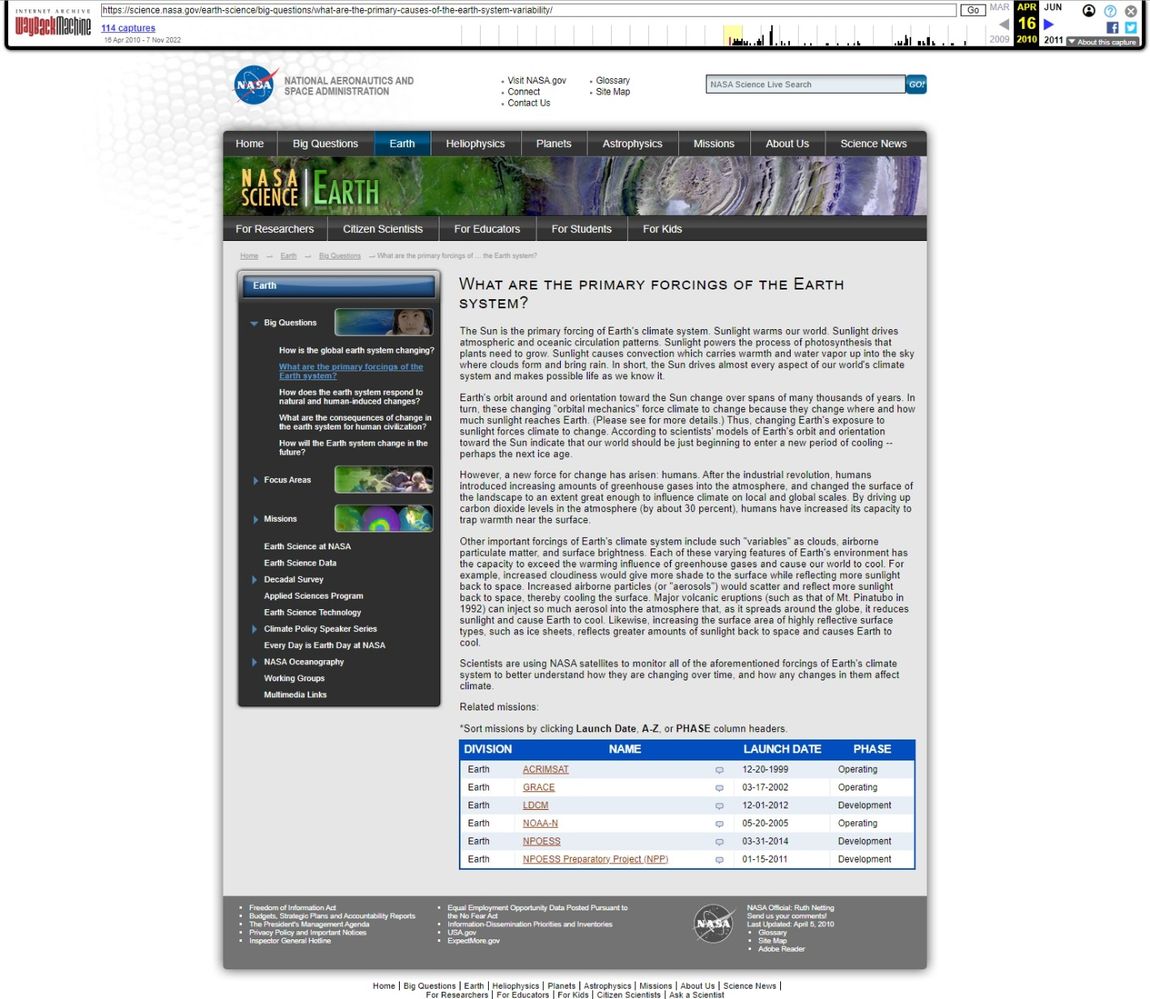Climate Catastrophe Fund
- a fund of information to read
- with links to the actual reports not just media summaries
Albert Einstein:
“Why 100? If I were wrong, one would have been enough."
[In response to the book "Hundred Authors Against Einstein"]”
Climate at a Glance
A straight forward explanation of many climate issues including sea levels, ice caps and animals
What NASA said are the primary forcings of the Earth's climate system?
The Sun is the primary forcing of Earth's climate system. Sunlight warms our world. Sunlight drives atmospheric and oceanic circulation patterns. Sunlight powers the process of photosynthesis that plants need to grow. Sunlight causes convection which carries warmth and water vapor up into the sky where clouds form and bring rain. In short, the Sun drives almost every aspect of our world's climate system and makes possible life as we know it.
Earth's orbit around and orientation toward the Sun change over the years. In turn, these changing "orbital mechanics" force climate to change because they change where and how much sunlight reaches Earth. Thus, changing Earth's exposure to sunlight forces climate to change. According to scientists' models of Earth's orbit and orientation toward the Sun indicate that our world should be just beginning to enter a new period of cooling -- perhaps the next ice age.
Source: NASA website: http://web.archive.org/web/20100416015231/https://science.nasa.gov/earth-science/big-questions/what-are-the-primary-causes-of-the-earth-system-variability/
Follow or copy the link to read (but may be blocked if you aren't allowed to question the narrative):
"In addition to the effects of climate on agriculture, there are some potentially catastrophic events that must be considered. For example, if the Antarctic ice sheet which is anchored on land should melt, then this could cause a rise in sea level on the order of 5 meters. Such a rise would cause flooding on much of the U.S. East Coast, including the State of Florida and Washington, D.C. The melting rate of polar ice is being studied by a number of glaciologists. Estimates for the melting of the West Antarctica ice sheet range from hundreds of years to a thousand years."
From: Exxon CO2 "Greenhouse" Effect 1982 Page 13
The Contingency Theory of Climate Change
Everywhere on the planet is very slightly different. So:
Climate change is the net result of all local, regional and global climate change variables, and CO2 is not the planet’s temperature control switch. You cannot dial up and down the temperature you want.
CO2 is just one of many climate change variables, including:
1) Earth’s orbital and orientation variations towards the Sun (aka planetary geometry)
2) Changes in ocean circulation. Including ENSO (El Nino) and others
3) Solar energy and irradiance, including clouds, albedo, volcanic and manmade aerosols, plus possible effects of cosmic rays and extra terrestrial dust
4) Greenhouse gas emissions (of which CO2 is one, and water vapour the most abundant)
5) Land use changes (cities growing - urban heat island effects, logging, crop irrigation, etc.)
6) Unknown causes of variations of a complex, non-linear system
7) Unpredictable natural and manmade catastrophes
8) Climate measurement errors (unintentional errors or deliberate)
9) Interactions and feedbacks, involving two or more variables.
——
So climate change is a soup of pretty much whatever flavour you like somewhere. Carbon dioxide is at most a very minor part of the equation.
Hydrogen is not the answer because there are many issues surrounding hydrogen.
Some of the basic issues:
To get hydrogen gas from water/methane takes a lot of energy as hydrogen forms strong chemical bonds, it has a relatively low calorific density (you get less bang for your buck), transporting and storing it is difficult (think of putting peas into a very big box of footballs and giving it a shake, the peas will end up at the bottom.
Hydrogen is the smallest atom and diffuses through its container walls, the container walls are like the footballs).
Hydrogen collects at defects within materials (no material is without defects) and forms gaseous hydrogen which makes the material brittle.
The above issues are scientific facts and you cannot change the laws of physics.
However there is an IEA report on hydrogen you can download from the link below.
Also said by NASA - The climate models are running too hot
Many of the world’s leading models are now projecting warming rates that most scientists, including the model makers themselves, believe are implausibly fast.
In advance of the last U.N. report, scientists scrambled to understand what went wrong and how to turn the models, which in other respects are more powerful and trustworthy than their predecessors, into useful guidance for policymakers.
“It’s become clear over the last year or so that we can’t avoid this,” said Gavin Schmidt, director of NASA’s Goddard Institute for Space Studies.
See below to read the article on hot models from Nature magazine May 2022.

The video below is the former FT Lex editor's views on climate catastrophe; and why investors need not worry.
Stuart Kirk has an MA in economics from Cambridge; was editor of the Financial Times prestigious Lex column for 7 years; and head of research at Deutsche Bank and HSBC.
The video is only 16 minutes and is quite amusing except for central bankers, such as Mark Carney.

